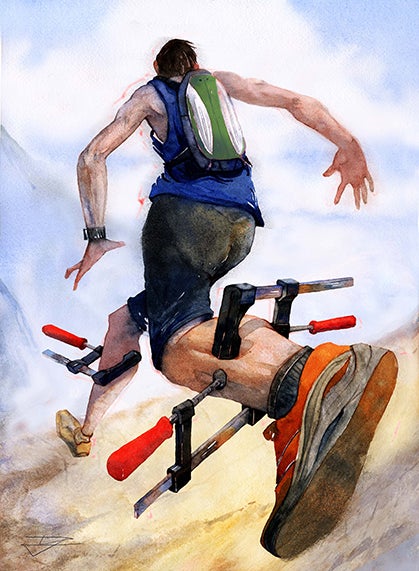Got Cramps?

Avoid painful race- and training-ending muscle spasms
In high school, I was leading a cross-country race, with a pack of runners from another school right off my shoulder. …
Illustration by Daniel Yagman
In high school, I was leading a cross-country race, with a pack of runners from another school right off my shoulder. I felt confident, and then with 800 meters to go, a cramp seized my calf. I stuttered for a few steps, and the entire pack flew by me as if I were standing still.
Have you ever been running along enjoying a trail’s scenery, the smell of tall pines or eucalyptus and BAM—you get a nasty cramp? Whether it is a sharp stitch in the side of your abdomen or a sudden, piercing tightness in your calf or hamstring, cramps can downright destroy an otherwise great run. But they don’t have to if you understand how to deal with (and avoid) them.
Why Do You Get Cramps?
Side stitches affect nearly 70 percent of runners, typically occur on the right side of the upper abdomen and are less prevalent in both older and fitter runners. Why cramps occur, though, is still somewhat of a mystery to physiologists and doctors. Scientists believe that side stitches, which are given the fancy name of exercise-related transient abdominal pain (ETAP), result from either eating or drinking too close to running, especially food and drink that has a high sugar content, or from the movement of internal organs inside the abdominal walls, causing their connective tissue to pull on the diaphragm, which moves with breathing.
While many runners believe that muscle cramps are caused by dehydration and/or an electrolyte imbalance, which could theoretically affect a muscle’s ability to contract, research has shown that neither is the cause. Drinking a sports drink on your long trail runs, while helpful to maintain hydration, won’t prevent cramping.
Experts now believe muscle cramps are caused by an increase in running pace and premature muscle fatigue, which affects the nervous system’s ability to relax a muscle after it has contracted. Trail running in particular can cause local muscle cramping since there is more stress on the muscles of the lower leg as they navigate uneven terrain. Cramps tend to occur when runners run farther or faster than they are used to and occur more often in muscles that cross more than one joint, such as the gastrocnemius muscle in the calf (which crosses the ankle and knee) and the biceps femoris (one of the hamstring muscles, which crosses the hip and knee).
Research has also shown that cramping is more common in athletes who have a family history of muscle cramps and a personal history of cramping and tendon and/or ligament injuries.
How Can You Get Rid of Cramps?
If you get a side stitch while running on trails, slow your pace a little and take some deep, even breaths. Try bending forward while tightening your abdominal muscles and massage the area with your fingers. For muscle cramps, stop and passively stretch the muscle. Since muscle groups work in opposing pairs, with one muscle group relaxing while its opposing muscle group contracts, you can also try to relax the cramp by voluntarily contracting the muscle group opposing the cramped muscle. For example, if you get a cramp in your hamstrings, try contracting your quadriceps, which should help the hamstrings relax.
Next time you get a cramp on the trails, don’t panic. Just follow this simple advice—and make sure no other runners pass you.
Dr. Jason Karp is a nationally-recognized coach, 2011 IDEA Personal Trainer of the Year and owner of RunCoachJason.com. He holds a Ph.D. in exercise physiology and is founder of REVO2LT Running Team. He writes for international running, coaching and fitness magazines, and has authored five books (www.runcoachjason.com/merchandise).
PREVENTING CRAMPS
• Warm-up sufficiently.
• Avoid abrupt changes in your running pace.
• Strengthen the muscle that is vulnerable
to cramping.
• Stretch the muscle that is vulnerable
to cramping.
• Strengthen your core muscles to support the abdominal contents.
• Do not eat within two of hours of hitting the trail. A full, distended stomach can place greater stress on the abdominal area.
• Train more and on race-simulating terrain to improve your fitness, which can prevent premature muscle fatigue.